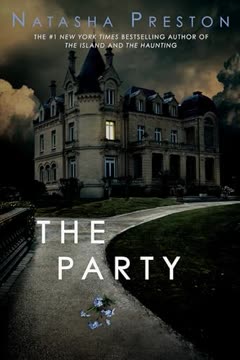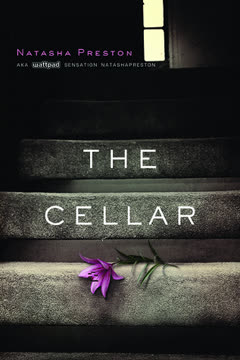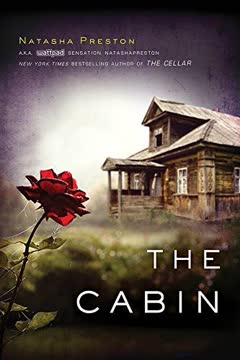Plot Summary
Secret Plans and Storm Warnings
Bessie and Kashvi, inseparable since childhood, are buzzing with anticipation for a forbidden weekend: a party in Allegra's family's remote, half-derelict castle. Their tight-knit group—Allegra, her twin Fergus, Zeke, Shen, Jia, and a few others—have all lied to parents and school to make this happen. But beneath the excitement, Bessie senses tension: the group is drifting, and something unspoken lingers from a past accident. Kash, the planner, has memorized every detail, but even she's uneasy about Allegra's insistence on a secretive route and the avoidance of the local village, where anti-development sentiment simmers. As the girls pack, the weather app promises a storm, but they're determined: this is their last chance for a wild, unsupervised adventure before adulthood closes in.
Arrival at the Isolated Castle
The friends execute their plan, splitting into cars and taxis, dodging suspicious teachers and parents. At a village shop, Bessie and Kash encounter Oscar, a local boy whose family leads the anti-castle-development protests. He warns them about the castle's history and the villagers' anger—some would rather see it burn than become luxury apartments. The girls are rattled, but keep the encounter secret. Arriving at the castle, they're awed by its grandeur and isolation, but the moat, rickety bridge, and hidden cars hint at deeper secrecy. Inside, the castle is cold, beautiful, and eerie. Allegra lays down strict rules: stick to certain rooms, don't leave evidence, and above all, don't get caught. The storm begins to roll in, sealing them off from the world.
Tensions, Threats, and Old Wounds
As they settle in, the group's dynamics show cracks. Allegra's controlling nature grates, and Fergus's charm can't mask his distance from Bessie, his ex. Zeke questions the convoluted route, and the group debates the villagers' threats. Graffiti and online posts reveal real hostility toward the Beaufort family. The friends try to brush it off, but unease grows. Bessie and Kash explore the castle, finding hateful graffiti in the cellar—threats that feel personal, not just anti-development. The storm intensifies, and the moat rises. The group's sense of invincibility begins to erode, replaced by a creeping sense of being watched, of secrets lurking in the castle's shadows.
The Storm Breaks, An Accident Strikes
The party setup is interrupted by a sudden, violent storm. Jia, out gathering wood, is struck by a falling tree. The group races into the rain to rescue her, dragging her inside, cold and bleeding. She's unconscious, but revives after being warmed and cared for by Kash and Shen, the group's aspiring medics. The phones lose signal, and the bridge is nearly underwater. The group debates calling for help, but Jia refuses, fearing exposure. The storm rages, trapping them. As night falls, the castle feels less like a playground and more like a prison. Bessie glimpses a figure in the window, but can't be sure if it's real or her imagination.
Graffiti, Secrets, and Rising Water
Bessie and Kash return to the cellar, finding evidence someone has been sleeping there—dust disturbed, a sleeping bag's outline. The graffiti is angrier, more personal. Upstairs, the girls' room overlooks the moat, which is rising alarmingly fast. The group realizes the storm has cut them off: the bridge is nearly submerged, the roads are flooded, and the castle is surrounded by water. The party's mood sours as the reality of their isolation sets in. Jia's injury is downplayed, but Bessie and Kash worry it's more serious. The group tries to distract themselves with music and drinks, but the sense of unease grows.
Jia's Injury and the First Night
Despite her protests, Jia is clearly in pain—headache, chest ache, bruising. She drinks to mask it, and the group tries to keep the party going, but Bessie and Kash are on edge. The storm shows no sign of letting up, and the moat is now a lake. Phones are dead or missing, and the castle's generator is unreliable. Bessie and Hugo, a late arrival, explore the cellar and find fresh graffiti: "Leave while you can." The group debates whether the threats are real or just local bluster, but the tension is palpable. As night falls, the castle's darkness feels oppressive, and everyone is on edge.
Flooded In, Party On
With the storm raging and escape impossible, the friends try to make the best of it. They drink, dance, and play games, but the mood is forced. Jia's pain is obvious, but she insists she's fine. Bessie and Kash worry, but can't convince her to rest or seek help. The group's old wounds—especially the mysterious accident that fractured their bond—bubble to the surface. Allegra's perfectionism clashes with the castle's decay, and Fergus's protectiveness of Bessie feels more like control. The night is restless, filled with uneasy dreams and the sense that something is very wrong.
Unsettling Discoveries in the Cellar
The next day, the group splits up to search for missing phones and clues. Bessie, Hugo, and Abbas find a hidden bag containing their phones (all dead), surveillance photos of the castle, and a kill list—with Bessie's name next. The evidence points to someone within the group, or at least someone with intimate knowledge of their plans. Paranoia sets in: accusations fly, alliances shift, and everyone is a suspect. The generator fails, plunging the castle into darkness. The group realizes they are not just trapped by the storm, but by a deliberate, malevolent force.
The First Death: Jia
Morning brings horror: Jia is dead in her bed, cold and lifeless. The girls' phones are missing, and it's clear someone entered the room while they slept. The group is thrown into chaos—was it her injuries, or something more sinister? With no way to call for help, and the bridge destroyed, they are truly trapped. Allegra and Fergus insist it was an accident, but Kash and Bessie suspect foul play. The group's unity shatters as fear and suspicion take hold. The castle, once a symbol of freedom, is now a tomb.
Phones Gone, Panic Rises
The group discovers all their phones are gone, and the cars have been sabotaged—starter motors destroyed, batteries dead. Attempts to cross the moat nearly end in disaster as the bridge collapses. The group is forced to retreat, wet and freezing, to the castle. Theories abound: is it the villagers, one of their own, or an unknown intruder? The discovery of a kill list and surveillance photos deepens the mystery. The group barricades themselves in the ballroom, but trust is gone. Every noise is a threat, every friend a possible killer.
Trapped and Sabotaged
As the group searches for answers, Odette is pushed from a window and killed. Abbas is found brutally murdered in a bathroom, his body mutilated. The killer is escalating, and the group is picked off one by one. Paranoia reaches fever pitch: accusations fly, old secrets are dredged up, and alliances fracture. Bessie and Kash discover a hidden room where the bodies are being stored. The group realizes the killer is among them, and that the motive is deeply personal—tied to the accident that haunts them all.
The Body Count Grows
Kash is stabbed and dies in Bessie's arms. Zeke is killed in a confrontation with the killer. Allegra's boyfriend Shen is murdered, and Allegra herself is killed by one of the murderers. Bessie and Hugo, wounded and traumatized, try to escape through the flooded grounds. The killers are revealed: Fergus, Allegra's twin, and Raif, Hugo's brother and the group's former friend, who was blamed for the accident that fractured the group. Their motives are twisted: revenge, jealousy, and a desire to destroy the group from within.
Paranoia, Accusations, and Alliances
As the survivors dwindle, Bessie and Hugo confront the killers. Fergus confesses to framing Raif for the accident, manipulating everyone, and orchestrating the murders. Raif, broken by guilt and anger, has become Fergus's accomplice. The group's old wounds—betrayal, guilt, and the need for control—are laid bare. In a final confrontation, Fergus and Raif turn on each other, and both are killed. Hugo is mortally wounded, and Bessie is left alone, traumatized and unsure of her own memories.
The Killers Revealed
Fergus and Raif, once friends, reveal the full extent of their crimes. Fergus manipulated Raif into believing Bessie was responsible for the accident, fueling his rage and desire for revenge. In truth, Fergus was the driver, and Bessie's memory was manipulated by trauma and suggestion. The murders were a twisted attempt to settle old scores and destroy the group. In the end, Fergus kills Raif, and Hugo kills Fergus, but not before being fatally wounded himself. Bessie, the last survivor, is left to piece together the truth.
Final Confrontations and Truths
Alone, Bessie escapes the castle, haunted by flashes of memory: blood, glass, screams. She finds Raif's car and drives away, unsure if she truly remembers the accident or if Fergus's final confession was another manipulation. The castle, once a symbol of freedom and friendship, is now a monument to betrayal and loss. Bessie is left with the knowledge that survival comes at a price, and that the truth is never as simple as it seems.
Aftermath: Memory and Survival
Bessie, traumatized and alone, is left to confront the aftermath of the weekend. The truth about the accident remains uncertain—her memories are fragmented, and Fergus's manipulations linger. The group is gone, destroyed by secrets, lies, and the darkness within. The castle stands empty, a testament to the dangers of unchecked privilege, unresolved trauma, and the illusion of safety. Bessie's survival is both a victory and a burden, as she must live with the knowledge of what happened—and what she may have done.
Characters
Bessie
Bessie is the story's narrator and emotional core—a loyal friend, cautious planner, and the glue of her group. Her relationship with Fergus, her ex, is fraught with unresolved feelings and guilt over a past accident that fractured the group. Bessie's psychological journey is one of mounting anxiety, self-doubt, and trauma, as she's forced to confront the darkness in her friends and herself. Her need for control and truth drives her to investigate, even as paranoia and fear threaten to overwhelm her. In the end, Bessie is the sole survivor, left to question her own memories and the cost of survival.
Kashvi (Kash)
Kash is Bessie's closest confidante—organized, intelligent, and fiercely loyal. She's the planner, the researcher, the one who tries to keep everyone safe. Kash's anxiety and sensitivity make her both a grounding force and vulnerable to panic. Her relationship with Bessie is deep and complex, marked by mutual dependence and unspoken feelings. Kash's death is a devastating blow, symbolizing the loss of innocence and the collapse of the group's support system.
Fergus
Fergus is Allegra's twin and Bessie's ex-boyfriend—a charming, privileged boy with a dark side. Outwardly protective and reliable, Fergus is revealed as the mastermind behind the murders, driven by jealousy, resentment, and a need for control. His psychological unraveling is gradual, masked by concern for Bessie and the group. Fergus's ultimate betrayal is rooted in his own sense of inadequacy and a desire to destroy what he cannot possess. His manipulation of Raif and the group is both chilling and tragic.
Allegra
Allegra is the party's organizer and the group's social center—demanding, image-conscious, and desperate for control. Her need for perfection masks deep insecurity and a fear of abandonment. Allegra's relationship with Fergus is intense and codependent, and her friendship with Bessie is marked by rivalry and affection. As the group unravels, Allegra's composure collapses, revealing her vulnerability. Her death is both a shock and a release from the pressures she placed on herself and others.
Hugo
Hugo is Raif's brother and a late arrival to the party—handsome, athletic, and emotionally guarded. He's haunted by his brother's absence and the group's fractured past. Hugo's loyalty to Bessie and his friends is unwavering, but he's also quick to anger and suspicion. His psychological arc is one of grief, guilt, and a desperate need for justice. Hugo's final act—killing Fergus to save Bessie—cements his role as a tragic hero, sacrificing himself for the group's last survivor.
Raif
Raif is Hugo's brother and the group's former friend, blamed for the accident that shattered their bond. His absence looms over the group, fueling guilt and suspicion. Raif's psychological journey is one of isolation, resentment, and vulnerability to manipulation. Fergus exploits Raif's guilt, turning him into an accomplice in the murders. Raif's final confrontation with Fergus reveals the depth of his pain and the consequences of unresolved trauma.
Jia
Jia is a gentle, caring member of the group, close to Shen and Kash. Her injury and subsequent death are the first signs that something is deeply wrong. Jia's refusal to seek help, her desire to keep the group together, and her ultimate vulnerability make her both a symbol of the group's innocence and the first casualty of its collapse. Her death triggers the group's descent into paranoia and fear.
Zeke
Zeke is practical, skeptical, and often the first to question the group's plans. His loyalty is tested as the situation deteriorates, and his attempts to find rational solutions are thwarted by sabotage and violence. Zeke's death is a turning point, marking the end of hope for escape and the triumph of chaos over reason.
Shen
Shen is Allegra's boyfriend and Jia's oldest friend—loyal, gentle, and eager to please. His role is often to mediate conflicts and provide emotional support. Shen's death, witnessed by Allegra, is a devastating blow that shatters her remaining composure and signals the killers' willingness to destroy anyone in their way.
Odette
Odette is a friend of Hugo and Abbas, invited to the party as an outsider to the core group. Her curiosity and independence set her apart, but also make her vulnerable. Odette's death—pushed from a window—is both shocking and senseless, underscoring the killers' escalating violence and the group's helplessness.
Plot Devices
Isolated Setting and Storm
The castle's remote location, surrounded by a rising moat and battered by a relentless storm, is both a literal and metaphorical prison. The storm cuts off escape routes, destroys the bridge, and sabotages communication, heightening the group's vulnerability. The setting amplifies paranoia, forcing the characters to confront not only external threats but the darkness within themselves. The castle's hidden rooms, secret passages, and decaying grandeur mirror the group's fractured relationships and buried secrets.
Unreliable Narration and Memory
Bessie's unreliable memory of the accident is a central plot device, creating ambiguity about guilt, motive, and truth. Flashbacks, hallucinations, and manipulated recollections blur the line between reality and suggestion. The killers exploit this uncertainty, planting false evidence and gaslighting the survivors. The reader, like Bessie, is forced to question what is real and who can be trusted.
Sabotage and Locked-Room Mystery
The deliberate destruction of phones, cars, and the bridge transforms the party into a locked-room mystery. The group's attempts to escape are thwarted at every turn, forcing them to turn inward and confront the possibility that the killer is among them. The escalating body count, hidden evidence, and shifting alliances create a claustrophobic atmosphere of suspicion and fear.
Red Herrings and Misdirection
The narrative is rife with red herrings: the villagers' threats, the anti-development group, Allegra's controlling behavior, and the group's own secrets. Surveillance photos, kill lists, and hidden rooms mislead both characters and readers. The true killers—Fergus and Raif—are revealed only after a series of false accusations and shifting alliances, keeping the reader guessing until the final confrontation.
Psychological Manipulation and Gaslighting
Fergus's manipulation of Raif, Bessie, and the group is a masterclass in psychological control. By exploiting guilt over the accident, planting false memories, and orchestrating violence, Fergus turns friends into enemies and victims into suspects. The group's descent into paranoia and self-doubt is both a cause and consequence of the killers' success.
Analysis
Natasha Preston's The Party is a chilling exploration of privilege, trauma, and the corrosive power of secrets. Set against the backdrop of a decaying castle and an unrelenting storm, the novel uses classic locked-room mystery tropes to probe the psychological unraveling of a group of friends bound by guilt and betrayal. The isolation of the setting is both physical and emotional, forcing the characters to confront not only external threats but the darkness within themselves. The narrative's use of unreliable memory, red herrings, and shifting suspicion keeps the reader in a state of uncertainty, mirroring the characters' own confusion and fear. At its core, the novel is a meditation on the dangers of unresolved trauma and the ways in which privilege can shield—and ultimately destroy—those who wield it. The final revelation—that survival comes at the cost of innocence, trust, and perhaps even truth itself—lingers long after the last page, challenging readers to consider the price of secrets and the fragility of friendship.
Last updated:
Review Summary
The Party receives mixed reviews, with an average rating of 3.53/5. Some praise its suspenseful plot and unexpected twists, while others criticize the writing style, character development, and plot holes. Positive reviews highlight the locked-room mystery and atmospheric setting. Negative reviews mention inconsistencies, unrealistic dialogue, and a disappointing ending. Many readers found the book engaging but felt the resolution was unsatisfying. Despite criticisms, some fans of Preston's work still enjoyed the thrilling elements and fast-paced narrative.
Download PDF
Download EPUB
.epub digital book format is ideal for reading ebooks on phones, tablets, and e-readers.








